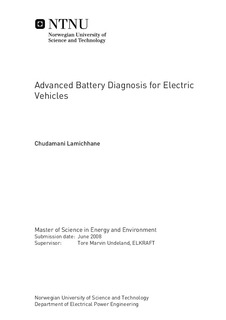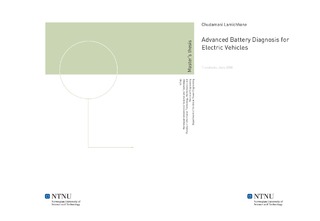| dc.description.abstract | Summary Literatures on battery technologies and diagnosis of its parameters were studied. The innovative battery technologies from basic knowledge to world standard testing procedures were analysed and discussed in the report. The established battery test station and flowchart was followed during the battery test preparation and testing. In order to understand and verify the battery performance, the well established test procedures developed by USABC (United States Advanced Battery Consortium) and FreedomCAR were reviewed. Based on the standard battery test flow diagram, battery test procedures are mainly categorised as below; 1. Test plan and pre-test readiness review 2. Core performance test charging, discharging, power, capacity and other special tests 3. Life cycle/ageing test accelerated ageing, calendar life, abuse and safety Commercial battery testers were used to carryout the core performance test but electrochemical impedance spectroscopy (EIS) was employed for life cycle test and also to investigate the state of health (SOH) and state of charge (SOC) of the battery. The standard test bench as shown below was used for the experiment under the scope of this thesis. Figure 1: Standard battery test station Study on impedance based modelling of battery and laboratory experiment to measure the impedance was carried out. Electrochemical impedance was measured by applying an AC potential to an electrochemical cell and measuring the current through the cell using the shunt in series where battery voltage was measured directly from the terminals as shown in figure 1.Commercially available battery sensors were used to measure the current, voltage and temperatures. Impedance was calculated internally and observed on computer through the battery test program and also observed on Nyquest plot where real part is plotted on the X-axis and imaginary part on Y-axis at one frequency. A typical impedance spectrum of a Li-ion battery tested in the laboratory at 250C is presented below. This figure shows the measured impedance for different state of charge (SOC) without dc excitation current. Figure 2: Impedance Spectra of a Li-ion battery At real impedance Re(Z) 42 m, the real axis intersection of the impedance spectra was observed in the figure 2. For lower frequencies, all spectra show two semicircles. The first semicircle is comparably small and slightly depressed, whereas the second one is larger, nearly non-depressed and grows remarkably with decreasing state of charge. Finally, at the low-frequency end of the depicted spectra, the diffusion impedance becomes visible. At high states of charge, the diffusion impedance shows a 45°-slope, which is typical of Warburg impedance (state of diffusion at certain frequency). | nb_NO |

